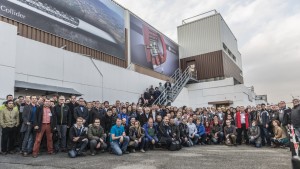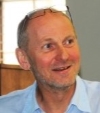
CLIC workshop participants gathering outside the CLIC test facility CTF3. Image: Anna Pantelia, CERN
The yearly CLIC collaboration meeting took place at CERN on 3-7 February 2014. A record participation of more than 300 scientists/students from the more than 70 collaborating institutes set the scene for a very busy and lively week. After completing the Conceptual Design Report (CDR) in 2012, and the European Strategy update in 2013, the discussions and presentations were refreshingly focused on the physics, technologies and scientific challenges for the next phase of the project.
The week started with an open plenary session on Monday 3 February afternoon giving an overview of the CLIC project – accelerator, physics/detectors, placed in the context of other studies for machines at the energy frontier. In addition to the CLIC option, a hadron machine in a large new tunnel, the Future Circular Collider (FCC), was highlighted as another possibility for a post-LHC high-energy frontier facility. The co-operation and common studies between CLIC and FCC are being developed and will be a priority in the coming years. The technical project developments will take place in parallel with LHC running at higher energies, hopefully providing guidance to the studies of future machine options.
The parallel sessions Tuesday 4 and Wednesday 5 February were the core of the workshop. One major goal of the workshop was to encourage presentations by young researchers and students and with around 150 presentations, most of them during the parallel sessions, this goals was achieved. The accelerator parallel sessions covered parameters and design, X-band activities, system tests – among them CTF3, FACET and ATF, implementation studies and technical developments – for example related to power/energy reduction, high-efficiency radiofrequency power systems, instrumentation studies and the newly initiated EU project PACMAN (Particle Accelerator Components Metrology and Alignment to the Nanometre scale). During the same days, the CLIC detector and physics community arranged their parallel sessions providing an overview of the current activities and future plans in these areas. An Institute Board meeting on Wednesday during lunchtime and a wrap up session in the afternoon completed the physics and detector sessions.
A special session on 6 February covered high-gradient normal-conducting accelerators for industrial and medical applications as well as XFELs (free electron lasers), using CLIC and other high-gradient technology developments. At this point in time, several of the key CLIC technologies have reached a level of maturity where applications in other areas than particle physics can be considered and open new possibilities. With this in mind, the CLIC collaboration invited laboratories, projects and industries with interests in these topics, including other frequency structures and power units, to an open “high gradient day”. Most of these laboratories and industrial suppliers are already involved in the CLIC study. The programme covered FEL-related projects and technologies, focusing on opportunities linked to high-gradient systems, followed by sessions on medical and industrial applications of high-gradient systems. In the afternoon there was a parallel session on low emittance rings, with emphasis on collaboration, technical developments and performance tests in and for light-sources and damping rings.
A plenary session on 7 February morning focused on system tests of key CLIC challenges, also with the aim of defining the future system test plans and opportunities that would be needed beyond CTF3 (the CLIC Test Facility) before construction. This included common studies with light-source and FEL laboratories, as well as several other accelerator test-facilities (as for example FACET at SLAC, US or ATF at KEK, Japan).
A Collaboration Board afternoon provided the opportunity to summarise the 2013 achievements and review the goals for 2014. Among the most clear goals are to complete re-baselining of a staged implementation taking into account the Higgs energy scale and improved power/cost models and to increase the X-band test capacity further providing the key to faster evaluation of accelerating structures and design optimisation steps. The CTF3 programme remains a key part of the collaborative efforts, and other experimental studies and programmes in conjunction with test-facilities and light source laboratories are high priority as mentioned above. Detector and physics studies towards energy-frontier physics and common reference studies with FCC where possible will be emphasised. On the organisational side, Phil Burrows was elected spokesperson for the accelerator collaboration for the next three years, replacing Roberto Corsini who had completed his term and was warmly thanked by the Collaboration Board.


Recent Comments